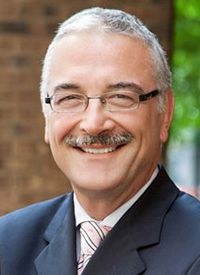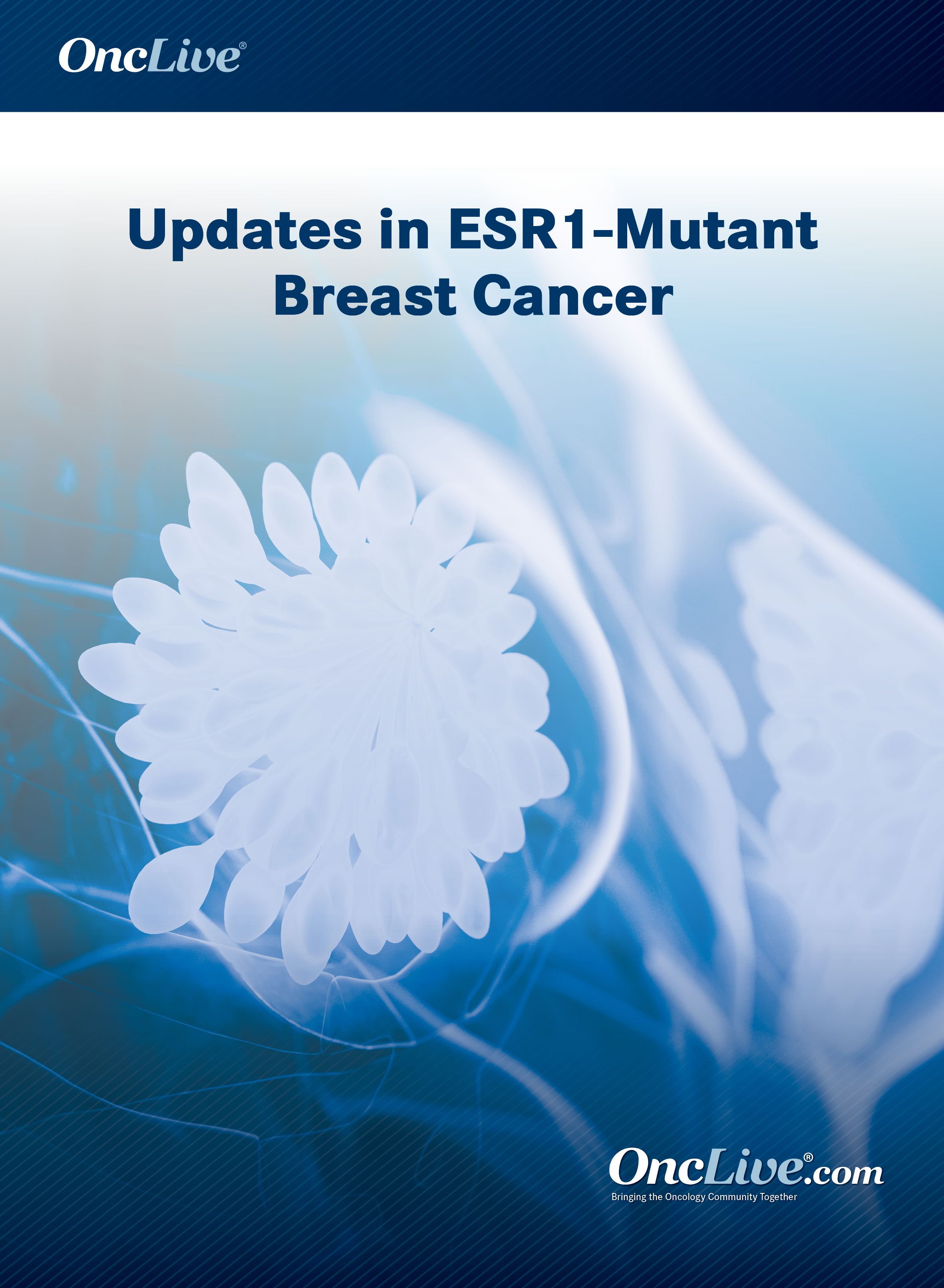Overcoming CDK4/6 Inhibitor Resistance in ESR1-Mutant HR+/HER2- Breast Cancer
Massimo Cristofanilli, MD, highlights the introduction of CDK4/6 inhibitors, such as abemaciclib, ribociclib, and palbociclib, which has been a significant addition to the hormone receptor–positive, HER2-negative breast cancer armamentarium.
Massimo Cristofanilli, MD

The introduction of CDK4/6 inhibitors, such as abemaciclib (Verzenio), ribociclib (Kisqali), and palbociclib (Ibrance) has been a significant addition to the hormone receptor (HR)–positive, HER2-negative breast cancer armamentarium, explained Massimo Cristofanilli, MD, who added that current questions regarding subsequent therapy selection can only be answered by testing for resistance mechanisms, such as ESR1mutations.
“We need to stress again the importance of molecular testing and make sure that patients participate in clinical trials,” said Cristofanilli. “We desperately need [novel therapies] because we don’t have many available options after fulvestrant [Faslodex]. ESR1 mutations span across 30% of patients [with estrogen receptor (ER)–positive, HER2-negative breast cancer], so perhaps CDK4/6 inhibitors will be used like trastuzumab [Herceptin] as a backbone for endocrine therapy.”
With regard to novel therapies, the potent selective estrogen receptor modulator (SERM) lasofoxifene is currently being investigated in the phase 2 ELAINE trial (NCT03781063) for use in patients with ER-positive, HER2-negative breast cancer whose tumors harbor an ESR1 mutation.
In May 2019, the FDA granted a fast track designation to lasofoxifene for use as a treatment for female patients with ER-positive, HER2-negative metastatic ESR1-mutant breast cancer.
The goal of the study is to identify a new therapeutic option for patients with ER-positive, HER2-negative metastatic breast cancer with de novo and acquired resistance. Additionally, patients in this space tend to have short-lived or no response to fulvestrant, which is the current standard of care.
In an interview with OncLive, Cristofanilli, a professor of medicine within the Hematology and Oncology Division at the Feinberg School of Medicine at the Robert H. Lurie Comprehensive Cancer Center of Northwestern University, discussed the nuances of treating patients with CDK4/6 inhibitors, the ongoing quest to understand mechanisms of resistance, and the potential role of lasofoxifene in the setting of ESR1-mutant, HR-positive, HER2-negative breast cancer.
OncLive: After a patient progresses on a CDK4/6 inhibitor, do you recommend continuing or switching CDK4/6 inhibitors?
Cristofanilli: In the management of patients with metastatic HR-positive disease, the standard of care is to use CDK4/6 inhibitors in combination with an endocrine agent. In the first-line setting, this would be an aromatase inhibitor (AI) and, in the second line, primarily fulvestrant.
Progression on CDK4/6 inhibitors is becoming a major challenge in the management of these patients because we have different situations. Patients will respond for a long time and then, after 1 or 2 years, eventually progress. In these cases, based on the [patients’] molecular profiles, we can decide to use a targeted therapy. We know about PIK3CA mutations, for example, for which alpelisib [Piqray] has been approved.
Then, there are situations of primary resistance to CDK4/6 inhibitors, which is much more complex. We frequently use chemotherapy very early on for these patients, but it depends on the lack of response in a short period of time, the particular mutation that is driving the resistance, and the site of recurrence. In a patient with bone metastases, we can try endocrine therapy, maybe with a novel agent or a simple agent targeting ESR1 mutations. In patients who have visual metastases, the standard of care is chemotherapy.
The pattern of management of these patients varies tremendously. [If patients have an] initial, long response to first-line palbociclib and progression where no specific driver mutation is identified, I would tend to use a different CDK4/6 inhibitor, such as abemaciclib.
How does the presence of an ESR1 mutation influence your treatment selection? How prevalent are ESR1 mutations among this patient population?
ESR1 mutations are probably the most interesting type of mutation that we see in metastatic breast cancer. Luminal breast cancer is very heterogenous. Of course, there is selective pressure from the treatment to develop new clones and new driver mutations.
ESR1 mutations have been discovered in patients who have primarily been exposed to AIs for a period of time; they are markers of resistance to AIs. In general, people believe that this is the most common [reason we see] ESR1 mutations.
At the same time, ESR1 mutations could be markers of resistance to endocrine therapy. Interestingly, most phase 3 clinical trials approached the approval of CDK4/6 inhibitors [by] evaluating cell-free DNA [cfDNA] for different mutations, including the frequency and onset of ESR1 mutations. ESR1 mutations were [present in] around 20% to 25% and increased slightly at the end of treatment and at the time of progression. Interestingly, some novel mutations appeared during treatment. This suggests that maybe resistance is no longer due to endocrine therapy. It makes me think that this is more related to fulvestrant. We have not dealt with that yet, meaning we don’t have a novel surge of [these types of agents] to substitute and address the question of whether ESR1 mutations indicate resistance to the combination or single-agent endocrine therapy.
Nevertheless, when we checked the ESR1 mutation level at baseline, it appeared that [the presence of a mutation] does not reduce the efficacy of palbociclib, for example. Interestingly, more recent data looking at the level of an ESR1 mutation before treatment with single-agent abemaciclib appeared to show a higher detection rate and increased percentage of ESR1 mutations compared with the combination. This suggests that if we use a CDK4/6 inhibitor up front, we may reduce the incidence of ESR1 mutations, thus reducing the specific type of endocrine disease.
Do you perform genomic testing for patients at each point of progression to look for potential resistance mutations?
The ability to interrogate the tumor, particularly with a type of mutation that we can target is very important. It makes us more willing to test tumors that progress on specific treatments. Clearly, it is not necessary for all our patients to have molecular testing, but when we have a patient who has recurred after a period of time, such as during adjuvant endocrine therapy or after first-line treatment, we must perform a molecular test to detect if a driver [mutation is present].
Of course, the more resistant the tumor becomes, the more important the value of testing becomes. We are talking about the evolution of the disease, so clearly, cfDNA testing is important. The standard of care is to do next-generation sequencing [NGS] in tissue at least once at the time of the patient’s first recurrence. Patients have a long natural history, and the disease evolution is better monitored with a cfDNA test.
How do the results of genomic tests guide subsequent treatment selection?
We learn more and more about the results of testing and how they can be applied [to treatment selection]. We mentioned that, for example, the detection of specific mutations indicate resistance or predict response to specific agents. If a patient has an [EGFR] mutation, for example, they may respond to the TKI neratinib [Nerlynx]. This particular target is [present] in about 5% of patients HR-positive disease, but it is a molecular alteration that patients gain during treatment with endocrine therapy.
Of course, we are pleased that we have an approved drug, alpelisib, and approved testing for patients with PIK3CA mutations. We are still learning how to manage adverse effects [AEs with alpelisib] because [the drug] has a clear role in the management of PIK3CA-mutated patients with HR-positive breast cancer in terms of improved outcomes and, even, improved survival.
Additionally, drug development for new ESR1-targeting agents to replace fulvestrant or to be used after fulvestrant [is ongoing] in a number of clinical trials. In order to be enrolled in these clinical trials, patients have to undergo molecular testing to show that a mutation is present. For this particular group of patients who progress after fulvestrant, it is important to be able to choose a type of treatment that is going to work after molecular testing.
This is just the beginning of what we have learned. For example, we know that particular NGS testing indicates tumor burden with allele frequency detection so we can understand how much disease [a patient has] and how aggressive the tumor is based on the molecular report and the evolution over time. We can detect that at recurrence, even before imaging. This may allow us to make changes in the treatment of some patients.
Also, in some patients, it is important to decide [the optimal] time to start chemotherapy based on the number of mutations that do not have a specific type of targeted therapy [available] that is associated with these molecular features.
Are there any notable differences between the safety profiles of the CDK4/6 inhibitors that may sway you to use one over another in a particular patient?
By now, we know very well how to use the [CDK4/6 inhibitors]. Palbociclib was the first-in-class agent to be approved, so we have a much longer history of monitoring and reporting AEs [with palbociclib]. Clearly, neutropenia is the most important AE. If a patient has a comorbid condition, such that their bone marrow is not able to [handle] palbociclib at multiple dose levels, we have the possibility to choose an alternative [drug].
We have patients who have gastrointestinal conditions, such as diarrhea, for which abemaciclib may not [be the optimal CDK4/6 inhibitor]. The toxicity profiles [of CDK4/6 inhibitors] are very well known.
The lung toxicity described with abemaciclib has also been consistently reported in a small percentage of patients who receive idelalisib [Zydelig].
Besides that, we are trying to figure out what specific characteristics of the tumor allow us to select 1 CDK4/6 inhibitor compared with another. The data have been reviewed in multiple different publications in a retrospective fashion. The efficacy on visceral metastases and primary resistance has an impact on overall survival.
How may the combination of the novel SERM lasofoxifene plus abemaciclib fit into the paradigm? What do we know about the safety profile of the regimen?
Right now, as we mentioned, in patients with ESR1 mutations, we have an agent that can safely be administered and show efficacy. Having a new agent that can be combined with a CDK4/6 inhibitor is an important way to deal with specific endocrine-resistant [disease] in which ESR1 is the driver.
The combination [of lasofoxifene] with abemaciclib is very intriguing because it can potentially identify the type of patient for which this particular combination will be tested against the standard of care. The safety profile is very consistent with published data. We need to [identify more opportunities for] testing, particularly with regard to the comparison with standard of care.
Perhaps, moving [the combination] very early on [would be beneficial] because most of these patients now progress on adjuvant therapy. We also know that many of these patients will be candidates for abemaciclib in the adjuvant setting. In the future, particularly for patients who develop resistance, it may be that high-risk detection reveals ESR1 mutations early on and this combination may be used in the adjuvant setting. A long road lies ahead, but we desperately [continue] to search [for answers], and these new data are encouraging.




